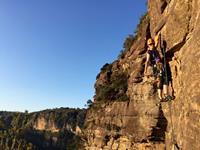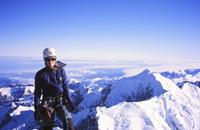Blog home / On the couch with Everest summiteer Allie Pepper
She’s well aware of the highs and lows that're in store when ascending at altitude on some of the world's highest peaks and it can prove to be more than just a mental or physical game. Though, one takeaway she says adventurers should always keep in mind when taking on their dream trek or climb is, quite simply, preparedness.
Being one of the handful of women in the world to have scaled Cho Oyu (8,201m) in Tibet solo and without the use of supplementary oxygen back in 2007, Allie Pepper's passion to climb ultimately led her to the summit of Mt Everest four years later. Along the way, she's led outdoor recreation activities since 1999 and guided expeditions in South America and the Himalaya, with her passion for adventure and climbing seeing her achieve many mountaineering feats, including the successful ascent of several high-altitude peaks in the Andes and the Himalaya, three of which were 8,000m mountains.
Climbing to the highest of heights, Allie Pepper shares tales from her most challenging expedition and what she finds special every time she travels to the Himalayas.
How did you first get into climbing?
I didn't discover rock climbing until I was 23 when I started my first Outdoor Recreation course at Blue Mountains TAFE. I was finding a career path after returning from 6 months travelling in India, and even though I grew up in the Blue Mountains, I never actually went outdoor climbing until then.
 Climbing in the Blue Mountains
Climbing in the Blue Mountains
I loved the course, especially learning technical climbing skills – I had finally found something that I was interested in and that I was good at.
I started working as an outdoor guide in Katoomba and, at the end of 1999, I went to New Zealand and completed a technical mountaineering course, which is where I discovered my passion for mountaineering.
I then had the opportunity to work on my first high altitude expedition in 2000 as an assistant guide on Aconcagua in Argentina – and I discovered there my strength at altitude. I have been climbing and guiding all over the world since.
You are the second Australian female, after Sue Fear, to summit an 8,000m peak without supplementary oxygen. What made you decide to attempt such a feat on Cho Oyu?
I spent around three years climbing and guiding in the South American Andes. I guided Aconcagua around 10 times and was working as a lead guide, and spent three seasons climbing on more technical peaks in the Cordillera Blanca of Peru. I was feeling very strong, fit and confident in my technical climbing abilities at altitude, so decided I was ready for the Himalaya.
 Allie has lead many expeditions in Argentina and Peru. She's pictured here at Alpamayo in 2002.
Allie has lead many expeditions in Argentina and Peru. She's pictured here at Alpamayo in 2002.
I chose Cho Oyu because I had met a Sherpa guide on Aconcagua who was organising the logistics for an American team on the mountain in Spring 2007. He was able to organise a small Base Camp for my climbing partner, Jason and I, at a reasonable price. We had a cook and one Base Camp dining tent, and we shared the transport to Tibet from Nepal with the other team. I never considered using oxygen at the time, and Jason and I acclimatised by trekking around the Everest region before our climb. I made a good acclimatisation plan, so either we would summit the mountain, or we would turn around. Either way, we didn't plan on using oxygen and didn't have any, so it wasn't an option!
How challenging was the Cho Oyu Peak summit?
Cho Oyu was the hardest thing I had ever done at the time. It was made harder because I ended up climbing alone. My climbing partner suffered bad frost nip on most of his toes during one of our rotations up the mountain, forcing him to stay at Base Camp while I went on the summit push. It took me eight days to summit and return to Base - and no one else went to the summit the day I did.
I had to plug a lot of steps in fresh snow by myself which was very tiring, especially at above 7,500m but it was one of the most rewarding climbs I have ever done because of the difficulties and I felt a great sense of achievement.
How would you compare it to climbing Everest?
I don't know how to compare it to Everest because it was more than 10 years ago, and the pain and suffering has faded in my memory. Everest had many other challenges as I did not climb in a team, just with one Sherpa named Dawa.
 Unforgettable memories forged. Dawa and Allie at Everest.
Unforgettable memories forged. Dawa and Allie at Everest.
I had to carry quite a heavy pack up high and I hadn't climbed at altitude for three years before the expedition. I had planned to try climb it without oxygen but on my second rotation I realised I was not fast enough to stay warm up high. I decided, last minute, to use oxygen and had to buy and borrow the equipment from teams in the Base Camp.
I had a mask that didn't fit my face which caused me a lot of trouble on summit day. We didn't have a satellite phone at the time, so we didn't know that the weather forecast had changed when we went to the summit.
Dawa and I started in clear skies but climbed into a storm. We had 10 metre visibility and 60km/h winds on the summit ridge. It was so cold it froze my water solid as well as my snacks inside my down suit, so I didn't eat or drink the whole day.
I was terrified as I had never climbed so high in such bad conditions; however, Dawa was confident to go on, so we did.
Thankfully, we made it to the top and back to camp that day. Sadly, a Japanese climber was not so lucky. Both expeditions were hard and took months to recover after them. I don't really know which one was harder.
 Allie standing at the top of Everest in 2011.
Allie standing at the top of Everest in 2011.
Whether one is trekking or mountaineering, what do you find special every time you travel into the Everest region?
Of course, the views are absolutely spectacular, and no photo really does them justice. You need to be there amongst the mountains to truly experience the beauty and energy of the Himalaya.
What I find the most special about being in that region, however, is the Sherpa people, who are so kind and generous. I have made many friends there and they are what I miss the most. The Sherpa are very friendly and respectful, and if you show them respect, they welcome you into their homes with open arms and open hearts.
How do you mentally train for your expeditions?
Every failure has taught me a lot about myself and my climbing and made me better prepared for the next expedition.
I have not succeeded on every climb, in fact, I would have turned around as many times as I have made the summit – there are so many other factors that can lead to an unsuccessful expedition. It doesn't matter in the end how much I want to stand on the summit because more than anything I want to stay safe.
 Allie scaled New Zealand's Mt Cook (3,724m) in 2003.
Allie scaled New Zealand's Mt Cook (3,724m) in 2003.
Being mentally prepared to fail is the hardest concept for most people, especially nowadays, when people are so focused on being successful and achieving their goals. This is one of the reasons why some climbers don't turn around when they should.
If you don't have years of experience to feel confident in your abilities, you need to train harder mentally. You need to push your comfort zones in your physical training to become more comfortable with suffering. Not just for a few minutes, like in Cross Fit for example, but for hours and hours. This is why ultra-running is a great sport to train for expedition climbing.
Being prepared physically and having all the technical skills needed for the expedition is going to put you in a better mental state. Sometimes a route on a mountain might involve a certain type of climbing that I am not very confident in. In that case, I need to train my weaknesses, so I am not nervous about that part of the climb and I am better prepared mentally.
When altitude sickness strikes, how would you cope?
Personally, I have only ever had altitude sickness once on a bus in Bolivia. We drove up too high too quickly and I had no idea how horrible it was until then. I started to sweat, wanted to vomit and my head felt like it was splitting open. Thankfully, we dropped in altitude pretty quickly and it went away. Since then I have a lot of empathy for people that have these symptoms.
I make sure my clients have a slow acclimatisation program when I plan expedition itineraries. We ascend slowly and steadily, to ensure that most people won't feel altitude sickness, but of course there is the odd occasion where someone in the team does. We usually then stop and spend an extra day at the same height rather than go up. Unless of course their symptoms are more severe, in which case they need to descend. This is rare on trips that I’ve led, but I have been involved in many rescues of people in other groups that have gone up too fast.
What are some highlights trekkers can experience on an Everest and Ama Dablam Base Camp trek?
When I think back to the first time I experienced this area, there are so many highlights! Flying into Lukla is always amazing as it is a short runway on the side of a steep mountain. I try to sit up the front to get the full exposure because I love it. Then there are the amazing stone houses and lodges – all built by hand, as well as Buddhist prayer wheels and Mani stones that line the trail. I love the yaks carrying loads in and out of Base Camp that share the trail with porters and trekkers; the views, the swing bridges, your first sight of Everest, the people, the smells, food and culture. Pretty much everything!
Climbing up Kala Pattar ... is amazing and has the best views of Everest in the Khumbu. Trekkers will also see Ama Dablam, a spectacular mountain that dominates the valley, so getting close to her walls is a great experience.
What’s your favourite part of Nepal?
Getting out of the city and onto the trail! After months of training, planning and organising, then shopping in Kathmandu for my expeditions, I just love getting into the mountains and hiking on the trail.
Everything becomes a lot simpler and life starts to slow down. For me, this is the least stressful part of the trip and the most enjoyable.
 Taking in the amazing scenery as they set up camp at the base of Lhotse.
Taking in the amazing scenery as they set up camp at the base of Lhotse.
What's your next goal?
My goal in terms of 8,000m mountains has always been to climb as high as I can without supplementary oxygen. After my trip with the Everest Base Camp trekkers, I plan to attempt this again, but I don't want to talk too much about which mountain until I have finalised logistics, so watch this space!
Feeling inspired? View our Nepal treks and start living your Himalayan dream >